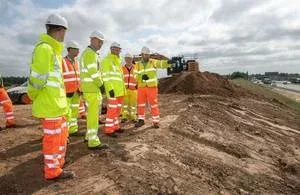Sustainability and climate change will be key considerations of future road design, thanks to the work of Highways England’s Strategic Design Panel.
The panel has published its fourth progress and recommendations. This report sets out the progress over the past year and a half (June 2019 to end of 2020) and makes key recommendations to take forward in the second road period.
The Panel has made the following key recommendations, which include:
- accelerate communication and training to promote and embed its design vision and principles into its processes and culture
- act on the Panel’s recommendations for adapting to climate change, reducing carbon, supporting biodiversity and the design of corridors
- publish a design strategy to clearly articulate its ambitions for the second road period and beyond
It is tasked with challenging and supporting Highways England to improve the quality of England’s strategic road network (SRN). The Panel’s role is to make sure that design excellence in landscape, engineering and built environment is considered in all of Highways England projects.
A key recommendation of the report suggests that road planning and design must accept the challenge to create a network resilient to climate change with an emphasis on sustainable design.
The report said: “Roads are long in their planning and long-lasting in operation. Designers must anticipate changes in long-term technological, social and environmental conditions under which they will function well into the future.
“Although it is acknowledged that road use rather than road operation or construction, is currently by far the largest generator of carbon emissions on the network, good planning and design can have a positive impact in all three areas.”
Mike Wilson, Chief Highway Engineer and Chair of the Highways England Strategic Design Panel, said: “The three essential qualities of good road design are safe, functional and elegant. And it is the latter, with careful attention to detail, that will elevate the quality of the network and deliver our vision of good design for people and places.
“In the second road period we will embed our principles of good road design further, so that their use becomes business as usual and second nature. I do not doubt there will be new design challenges ahead, but we have great multi-disciplinary design teams and with the support of the Strategic Design Panel, we will rise to these.”
Minnie Moll, Chief Executive at Design Council, said: “Infrastructure has the power to connect communities, boost economic growth and enhance the built and natural environment. Of course, this can only be achieved if it is well designed – with people and the planet considered throughout the process.
“I’m therefore delighted to see Highways England continue to place design at the heart of their work. Their establishment of a review panel, involving Design Council, to provide independent design advice for schemes has been a critical step forward. This work clearly demonstrates the value of multi-disciplinary thinking and uses our insights from best practice across major infrastructure projects.
“I am heartened by what has been achieved so far and now look forward to supporting Highways England to achieve their goals around sustainability and design. By working together, we can help ensure that England’s major roadways are of the highest design standards and leave a positive legacy.”
The Panel continues to positively influence the design of schemes, and specifically commended the landscape-led design approach of the proposed A417 Missing Link in Gloucestershire. The design of the scheme has embraced the principles of good design and goals of sustainable development to enhance both the character of the place and experience of people.
Advice from design reviews of the A417 Missing Link has encouraged a change in the proposed road’s gradient which will further reduce visual impact and also impacts on local woodland and water courses, waste, traffic, carbon footprint, and construction time, while making cost savings.
Steve Roberts, Lower Thames Crossing, Engineering Design Lead, said: “The advice of the Design Panel was invaluable in the shaping of our scheme proposals, particularly in the early stages of development, helping to define those factors that should influence the design and how the design should respond to its context.
“On a large complex project like Lower Thames Crossing, with significant inter-disciplinary working, the Design Panel, with its broad range of experts, was a useful forum to review the balance of constraints and opportunities within the scheme and the overall level of ambition in our design.”
The Panel includes members from across a range of disciplines, representing stakeholders who are committed to improving the design and quality of the SRN.
- Campaign for Better Transport
- Transport Focus
- Institution of Structural Engineers
- Chartered Institute of Highways and Transportation
- Institution of Civil Engineers
- National Trust
- Landscape Institute
- Connected Places Catapult
- Royal Institute of British Architects
- Design Council
- Campaign to Protect Rural England
- Historic England
- Natural England





















